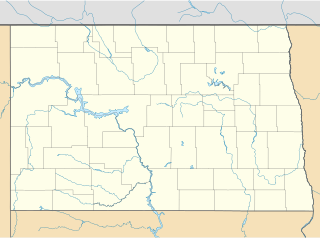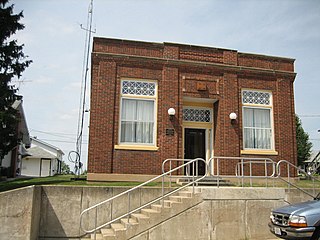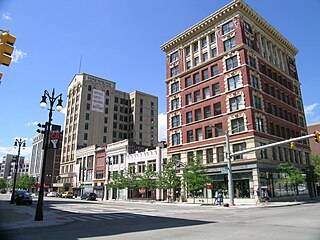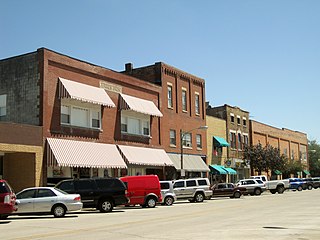Downtown East St. Louis Historic District | |
 Collinsville Avenue in 2003 | |
| Location | Portions of Collinsville, Missouri, and St. Louis Aves., East St. Louis, Illinois |
|---|---|
| Coordinates | 38°37′38″N90°9′32″W / 38.62722°N 90.15889°W Coordinates: 38°37′38″N90°9′32″W / 38.62722°N 90.15889°W |
| NRHP reference # | 14000622 [1] |
| Added to NRHP | September 17, 2014 |
The Downtown East St. Louis Historic District is a historic commercial district in downtown East St. Louis, Illinois. The district includes 35 buildings, 25 of which are contributing buildings, along Collinsville Avenue, Missouri Avenue, and St. Louis Avenue; all but one of the buildings was historically used for commercial purposes. While development in the area dates back to the late 19th century, the first of the extant buildings in the district were built around 1900 after a tornado devastated the area in 1896. By 1910, the area had become a prosperous commercial district with stores, offices, and entertainment venues; surviving buildings from this period include the Murphy Building and the Cahokia Building. Another large building boom took place in the 1920s, adding buildings such as the Spivey Building, the city's only skyscraper; the Union Trust Bank Company Building, the largest bank in the city; the Grossman Building; and the Majestic Theatre. The new buildings both coincided with a population and economic expansion in the city and allowed it to forge an architectural identity distinct from neighboring St. Louis. [2]

East St. Louis is a city in St. Clair County, Illinois, United States within Greater St. Louis. It is located directly across the Mississippi River from Downtown St. Louis and the Gateway Arch National Park. East St. Louis is in what is defined as the Metro-East region of Southern Illinois. Once a bustling industrial center, like many cities in the Rust Belt, East St. Louis has been severely affected by loss of jobs due to industrial restructuring during the second half of the 20th century. In 1950, East St. Louis was the fourth-largest city in Illinois when its population peaked at 82,366. As of the 2010 census, the city had a population of 27,006, less than one-third of the 1950 census.

Illinois is a state in the Midwestern and Great Lakes regions of the United States. It has the fifth largest gross domestic product (GDP), the sixth largest population, and the 25th largest land area of all U.S. states. Illinois has been noted as a microcosm of the entire United States. With Chicago in northeastern Illinois, small industrial cities and immense agricultural productivity in the north and center of the state, and natural resources such as coal, timber, and petroleum in the south, Illinois has a diverse economic base, and is a major transportation hub. Chicagoland, Chicago's metropolitan area, encompasses over 65% of the state's population. The Port of Chicago connects the state to international ports via two main routes: from the Great Lakes, via the Saint Lawrence Seaway, to the Atlantic Ocean and from the Great Lakes to the Mississippi River, via the Illinois Waterway to the Illinois River. The Mississippi River, the Ohio River, and the Wabash River form parts of the boundaries of Illinois. For decades, Chicago's O'Hare International Airport has been ranked as one of the world's busiest airports. Illinois has long had a reputation as a bellwether both in social and cultural terms and, through the 1980s, in politics.

The Spivey Building is a twelve-story skyscraper located at 417 Missouri Avenue in East St. Louis, Illinois. Built in 1927, the building is the only skyscraper ever constructed in East St. Louis. Architect Albert B. Frankel designed the building in the Commercial style. The building's design features terra cotta spandrels separating its windows vertically and brick pier dividing its window bays. The asymmetrical entrance is surrounded by decorative marble piers, and the first two stories are separated from the rest of the building by a cornice and sill. The top of the building features a two-story parapet with terra cotta surrounds at each window and seven capitals at its peak. During the height of East St. Louis' prosperity through the 1950s, the building housed the offices of professionals in many fields who were considered among the best in the city. However, the building became a victim of the city's steep economic decline and has been abandoned for several decades.
Beginning in the 1960s, East St. Louis and its downtown entered a period of dramatic decline. Several major businesses left the city for other suburbs, urban decay and blight struck the city, resulting in the abandonment or demolition of several major commercial buildings. In addition, the rise of the automobile and the construction of new expressways took foot traffic away from the downtown area, furthering the decline of its businesses. The city's population is now one-third of its peak in 1950, and many of the district's buildings are abandoned and at risk of demolition or major decay. [2]

Urban decay is the sociological process by which a previously functioning city, or part of a city, falls into disrepair and decrepitude. It may feature deindustrialization, depopulation or deurbanization, economic restructuring, abandoned buildings and infrastructure, high local unemployment, increased poverty, fragmented families, low overall living standards and quality of life, political disenfranchisement, crime, elevated levels of pollution, and a desolate cityscape, known as greyfield or urban prairie. Since the 1970s and 1980s, urban decay has been associated with Western cities, especially in North America and parts of Europe. Since then, major structural changes in global economies, transportation, and government policy created the economic and then the social conditions resulting in urban decay.
The district was added to the National Register of Historic Places on September 17, 2014. [1]

The National Register of Historic Places (NRHP) is the United States federal government's official list of districts, sites, buildings, structures and objects deemed worthy of preservation for their historical significance. A property listed in the National Register, or located within a National Register Historic District, may qualify for tax incentives derived from the total value of expenses incurred in preserving the property.




















